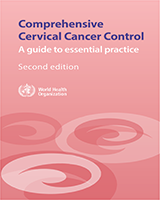Treatment of cervical infections
In case of a cervical infection, the woman and her partner should be treated and counselled on condom use.
View in own window
| Treatment for uncomplicated gonorrhoea and for chlamydia |
|---|
| Coverage | First choice
Choose 1 from each box below (= 2 medicines) | Special situation: pregnancy, breastfeeding or under 16 years old
Choose 1 from each box below (= 2 medicines) |
| Gonorrhoea* | ceftriaxone* 250 mg by intramuscular injection as a single dose
cefixime 400 mg orally as a single dose | cefixime 400 mg orally as a single dose
ceftriaxone 250 mg by intramuscular injection as a single dose |
| Chlamydia | azithromycin 1 g orally as a single dose
doxycyclinea 100 mg orally twice a day for 7 days | erythromycinb 500 mg orally 4 times a day for 7 days
azithromycin 1 g orally as a single dose
amoxicillin 500 mg orally 3 times a day for 7 days |
- *
The information in the table reflects WHO recommendations for treatment of cervical infections in 2011. These recommendations are being updated because of a high level of resistance of Neisseria gonorrhoea to quinolones and emerging decreasing susceptibility to cefixime and ceftriaxone (extended spectrum cephalosporin). Countries should be advised to take into consideration antimicrobial resistance patterns in N. gonorrhoea and follow national guidelines.
- a
Doxycycline, tetracycline, ciprofloxacin, norfloxacin and ofloxacin should be avoided in pregnancy and when breastfeeding.
- b
Erythromycin estolate is contraindicated in pregnancy because of medicine-related hepatotoxicity; only erythromycin base or erythromycin ethylsuccinate should be used.
Outpatient treatment for PID
In case of PID, the woman's partner should be treated for gonorrhoea and chlamydia, and the couple should receive counselling on condom use.
View in own window
| Single-dose therapy for gonorrhoea PLUS multidose therapy for chlamydia PLUS multidose therapy for anaerobic infections |
|---|
| Coverage | Choose 1 from each box (= 3 medicines) |
|---|
| Gonorrhoea* | ceftriaxonea 250 mg by intramuscular injection as a single dose
cefoxitin 2 g by intramuscular injection as a single dose |
|---|
| Chlamydia | doxycyclineb 100 mg orally twice a day for 14 days
erythromycinc 500 mg orally 4 times a day for 14 days |
|---|
| Anaerobes | metronidazoled 400–500 mg orally twice a day for 14 days |
|---|
- *
The information in the table reflects WHO recommendations for treatment of cervical infections in 2011. These recommendations are being updated because of a high level of resistance of Neisseria gonorrhoea to quinolones and emerging decreasing susceptibility to cefixime and ceftriaxone (extended spectrum cephalosporin). Countries should be advised to take into consideration antimicrobial resistance patterns in N. gonorrhoea and follow national guidelines.
- a
May consider increasing the dose based on resistance pattern of N. gonorrhoea in country (check with national guidelines)
- b
Doxycycline is contraindicated for pregnant or breastfeeding women. PID is uncommon in pregnancy.
- c
Erythromycin estolate is contraindicated in pregnancy because of medicine-related hepatotoxicity; only erythromycin base or erythromycin ethylsuccinate should be used.
- d
Patients taking metronidazole should be cautioned to avoid alcohol.
Note: Hospitalization of patients with acute PID should be seriously considered when:
a surgical emergency, such as appendicitis or ectopic pregnancy, cannot be excluded
a pelvic abscess is suspected
severe illness precludes management on an outpatient basis
the patient is pregnant
the patient is an adolescent
the patient is unable to follow or tolerate an outpatient regimen
the patient has failed to respond to outpatient therapy.

